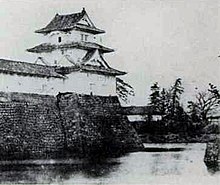Minami River
| Minami River | |
|---|---|
 Minami River in 2007 | |
| Native name | 南川 (Japanese) |
| Location | |
| Country | Japan |
| State | Honshu |
| Region | Fukui |
| Municipalities | Ōi, Obama |
| Physical characteristics | |
| Source | Tokinzan |
| • location | Ōi, Fukui Prefecture and Ayabe, Kyoto Prefecture |
| • coordinates | 35°22′38″N 135°32′04″E / 35.377222°N 135.534444°E |
| • elevation | 564 m (1,850 ft) |
| Mouth | Obama Bay |
• location | Obama, Fukui |
• coordinates | 35°30′14″N 135°44′20″E / 35.5038503°N 135.7389697°E |
• elevation | 0 m (0 ft) |
| Length | 34 km (21 mi) |
| Basin size | 460 km2 (180 sq mi) |
| Basin features | |
| Tributaries | |
| • left |
|
| • right |
|
The Minami River (南川, Minami-gawa) is a river in Fukui Prefecture, Japan. It is designated Class B by the Ministry of Land, Infrastructure, Transport and Tourism (MLIT). It empties into Obama Bay, a sub-bay of Wakasa Bay on the Sea of Japan about 280 metres (920 ft) southwest of the mouth of the Kita River.
Geography and development
[edit]The source of the Minami River is found near Amaki Pass on the slopes of Tokinzan (a mountain straddling the border between Ōi, Fukui Prefecture and Ayabe, Kyoto Prefecture) about 564 metres (1,850 ft) above sea level.[1] Minami River Sabō Dam (南川砂防ダム, Minami-gawa Sabō Damu) is located a few kilometers below the headwaters of the river. The river travels for 34 kilometres (21 mi) through the municipalities of Ōi (in Ōi District) and Obama before emptying into Obama Bay right next to the mouths of the Kita and Tada Rivers.[1][2]

The drainage basin for the river covers 460 square kilometres (180 sq mi).[1] The Fukaya, Kubotani, and Kuda Rivers in Ōi, and the Makitani, Okutanawa, Sakamoto, Somegatani, Sunawa, and Tamura Rivers in Obama are all tributaries.[1] The Ministry of Land, Infrastructure, Transport and Tourism designated the Minami a Class B river.[3] Japan National Route 162 runs alongside the Minami River from just below the Buddhist temple Dankeiji to near the river's mouth at Obama Bay.[4]
Obama Castle was built on the narrow delta formed by the mouths of the Minami, Kita, and Tada Rivers, giving the castle natural protection due to the rivers and Obama Bay protecting it on three sides.[2]
Flooding
[edit]In September 1953, heavy rainfall from Typhoon Tess caused major flooding along the Minami River and its tributaries, destroying many fields, damaging ships, and injuring or killing almost nearly 500 people.[5] Typhoon Trix in 1971 also caused major flooding, crop damage, and loss of life.[3]
Tributaries
[edit]The Minami River has several main tributaries.
- Fukaya River (五十谷川, Fukaya-gawa) (Obama)[1]
- Kubotani River (窪谷川, Kubotani-gawa) (Obama)
- Kuda River (久田川, Kuda-gawa) (Ōi)[1]
- Makitani River (槇谷川, Makitani-gawa) (Ōi)
- Okutanawa River (奥田縄川, Okutanawa-gawa) (Obama)
- Sakamoto River (坂本川, Sakamoto-gawa) (Ōi)[1]
- Somegatani River (染ヶ谷川, Somegatani-kawa) (Ōi)[1]
- Sunawa River (須縄川, Sunawa-gawa) (Obama)
- Tamura River (田村川, Tamura-gawa) (Obama)[1]
Flora and fauna
[edit]
The Minami River is home to many types of fish and other animals.
- Amur catfish[1]
- Ayu sweetfish[1]
- Big-scaled redfin[1]
- Dark chub[1]
- Dark sleeper[1]
- Eurasian carp[1]
- Flathead grey mullet[1]
- Fourspine sculpin[1]
- Ginbuna[1]
- Grass puffer[1]
- Gymnogobius:
- Ice goby[1]
- Japanese fluvial sculpin[1]
- Japanese gudgeon[1]
- Japanese river goby[1]
- Japanese sea bass[1]
- Japanese striped loach[1]
- Leiognathus nuchalis[1]
- Lethenteron:
- Liobagrus reinii[1]
- Oily bitterling[1]
- Oncorhynchus:
- Pale chub[1]
- Pond loach[1]
- Phoxinus:
- Pungtungia herzi[1]
- Rhinogobius:
- R. sp. CB[1]
- Lizard goby[1]
- R. giurinus[1]
- R. sp. LD[1]
- Whitespotted char[1]
- Sarcocheilichthys variegatus microoculus[1]
- Sharp-nosed sand goby[1]
- Squalidus gracilis[1]
- Tachysurus nudiceps (Pseudobagrus nudiceps)[1]
- Tridentiger:
References
[edit]- ^ Jump up to: a b c d e f g h i j k l m n o p q r s t u v w x y z aa ab ac ad ae af ag ah ai aj ak al am an ao ap aq ar as at au av aw ax ay az Matsumiya, Yoshitaka; Watanabe, Katsutoshi; Iguchi, Kei'ichiroh; Iwata, Hiroshi; Yamamoto, Gunji; Nishida, Mutsumi (4 June 2001). 福井県嶺南地方を流れる南川水系の淡水魚類 [Freshwater fish from the Minami River water system flowing through the Reinan region of Fukui Prefecture]. Japanese Journal of Ichthyology (in Japanese). 48 (2). The Ichthyological Society of Japan: 93–107. Archived from the original on 31 October 2020. Retrieved 10 January 2024.
- ^ Jump up to: a b 小浜城 [Obama Castle] (in Japanese). 福井県:歴史・観光・見所. Archived from the original on 11 January 2024. Retrieved 11 January 2024.
- ^ Jump up to: a b 南川水系 流域治水プロジェクト【位置図】 [Minamikawa River Basin Flood Control Project [Location Map]] (PDF) (in Japanese). Ministry of Land, Infrastructure, Transport and Tourism. March 2023. Archived (PDF) from the original on 11 January 2024. Retrieved 11 January 2024.
- ^ 小川秀夫; 栗栖国安; 田宮徹 (10 April 2016). 中村純一 (ed.). ニッポン絶景ロード100 [Japan Scenic Roads 100]. 周山街道 (in Japanese). EI Publishing. p. 94. ISBN 978-4-7779-3980-0.
- ^ 小出博 (Hiroshi Koide) (10 September 1954). 高潮と豪雨のために大水害 [Major Floods Due to High Surges and Heavy Rains]. 日本の水害 [Japan Flood Disasters] (in Japanese). Toyo Keizai. p. 32.


